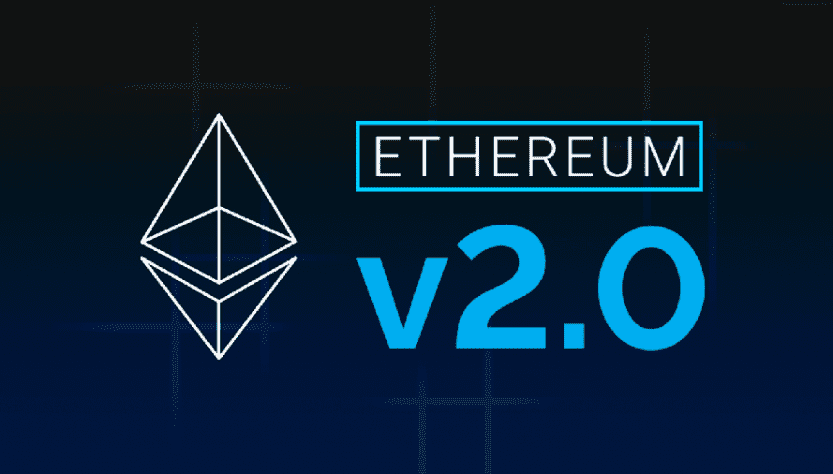The Ethereum network’s long-planned upgrade seeks to address scalability and security issues. The blockchain “world computer” will shift to a proof of stake consensus algorithm in the first phase.
It’s been a long time coming, but the first phase of Ethereum 2.0 has now entered into operation.
The multi-phased upgrade’s goal is to improve the Ethereum network’s scalability and security by making several modifications to the network’s architecture, notably moving from a proof of work (PoW) consensus mechanism to a proof of stake (PoS) model.
What is Ethereum 2.0?
Ethereum 2.0, often known as Eth2 or “Serenity,” is a blockchain upgrade for Ethereum. The aim of the upgrade is to improve the speed, efficiency, and scalability of the Ethereum network so that it can handle activities more easily.
The second stage of Ethereum 2.0, called the Beacon Chain, having gone live on December 1, 2020. The Beacon Chain is the first upgrade to the network’s PoS consensus mechanism and introduces native staking to the Ethereum blockchain. It is a distinct blockchain from Ethereum’s mainnet, according to its name.
The second phase, called The Merge, is expected in the first or second quarter of 2022 and will merge the Beacon Chain with the Ethereum mainnet.
The final phase is Shard Chains, and will play a key role in scaling the Ethereum network. Instead of settling all operations on one single blockchain, shard chains spread these operations across 64 new chains.
This also means that it is much easier from a hardware perspective to run an Ethereum node because there is far less data that needs to be stored on a machine.
Shard Chains aren’t expected until 2022, but it is unclear exactly when.
How does Ethereum 2.0 differ from Ethereum?
While Ethereum 1.0 uses a consensus mechanism known as proof-of-work (PoW), Ethereum 2.0 will use a proof-of-stake (PoS) mechanism.

How does proof of stake differ from proof of work?
With blockchains such as Ethereum, there is a need to validate transactions in a decentralized way. Ethereum, like other cryptocurrencies such as Bitcoin, currently uses a proof of work consensus mechanism.
In this system, miners use a machine’s processing power to solve complex mathematical puzzles and verify new transactions. The first miner to solve a puzzle adds a new transaction to the record of all transactions that make up the blockchain. They are then rewarded with the network’s native cryptocurrency. However, this process can be hugely energy-intensive.
Proof of stake differs in that instead of miners, users can stake a network’s native cryptocurrency and become validators. Validators are similar to miners in that they verify transactions and ensure the network isn’t processing fraudulent transactions.
These validators are selected to propose a block based on how much crypto they have staked, and how long they’ve staked it for.
Other validators can then attest that they have seen a block. When there are enough attestations, a block can be added to the blockchain. Validators are then rewarded for the successful block proposition. This process is known as “forging” or “minting.”
The main advantage of PoS is that it is far more energy-efficient than PoW, as it decouples energy-intensive computer processing from the consensus algorithm. It also means that you don’t need a lot of computing power to secure the blockchain.
How will Ethereum 2.0 scale better than Ethereum 1.0?
One of the main reasons for the upgrade to Ethereum 2.0 is scalability.
With Ethereum 1.0, the network can only support around 30 transactions per second; this causes delays and congestion. Ethereum 2.0 promises up to 100,000 transactions per second. This increase will be achieved through the implementation of shard chains.
How will Ethereum 2.0 be more secure?
Ethereum 2.0 has been devised with security in mind. Most PoS networks have a small set of validators, which makes for a more centralized system and decreased network security. Ethereum 2.0 requires a minimum of 16,384 validators, making it much more decentralized—and hence, secure.
However, according to Lior Yaffe, co-founder of Jelurida and lead core developer of the Ardor and Nxt blockchains, there is a potential vulnerability that focuses on the level of participation rates in the network.
Security audits of Ethereum 2.0 code are being carried out by organizations including blockchain security firm Least Authority and Quantstamp.
The Ethereum Foundation is also setting up a dedicated security team for Ethereum 2.0 to research possible cybersecurity problems in the cryptocurrency.
Ethereum 2.0 researcher Justin Drake stated that the research will include “fuzzing, bounty hunting, pager duty, cryptoeconomic modeling, applied cryptanalysis, formal verification.”
How is the Ethereum 2.0 upgrade going to take place?
Following a series of testnet launches, Topaz, Medalla, Spadina, and Zinken, the full roll-out of Ethereum 2.0 will take place in three phases: Phase 0, 1, and 2 (developers like to count from zero). Phase 0 launched on December 1, 2020, with the other phases set to arrive in the following years.
Phase 0 sees the implementation of the Beacon Chain; this stores and manages the registry of validators as well as deploying the PoS consensus mechanism for Ethereum 2.0. The original Ethereum PoW chain will run alongside this so there is no break in data continuity.
Phase 1, due in Q1/Q2 2022, will see the Ethereum mainnet merge with the Beacon Chain and officially bring an end to PoW on the network. Users who staked Ethereum on the Beacon Chain will then be assigned validator roles.
Phase 2 will introduce Shard Chains to the network, with an expected launch of 64 shards (enabling 64 times more throughput than Ethereum 1.0) though at launch they won’t support accounts or smart contracts.
Previous iterations of the roadmap placed the Merge event after the launch of Shard Chains, but due to each upgrades’ interoperability, it was later decided to flip these launch events.
“Originally, the plan was to work on shard chains before the merge – to address scalability,” reads documentation from the Ethereum Foundation. “However, with the boom of layer 2 scaling solutions, the priority has shifted to swapping proof-of-work to proof-of-stake via the merge.”
When was Ethereum 2.0 Released?
Ethereum 2.0’s Beacon Chain, the first stage in the release of Ethereum 2.0, went live at 12:00 pm UTC on December 1, 2020.
Speaking on the Ethereum 2.0 livestream, Danny Ryan, core researcher at the Ethereum Foundation, noted that, “Key to the health of this thing is we see participation over two-thirds.”
With the launch of the beacon chain confirmed, there are more than 21,000 active validators on the network at the time of writing, with each epoch seeing a success rate of over 80%.
The beacon chain will initially exist separate from the current Ethereum mainnet, before the mainnet is “docked” to the proof-of-stake system.
The first eligible block was slot 1, and its validator signed it with a cryptic message: “Mr F was here.”
The successful launch was celebrated by broad swaths of the Ethereum community, including Ethereum co-founders Vitalik Buterin and Joseph Lubin.
The launch followed a tense month of preparation too, in which certain criteria had to be met.
Following the release of the deposit contract on November 4, 2020, there needed to be 16,384 validators on the network by November 24, each staking 32 Ethereum, for a total of 524,288 ETH.
The launch followed a tense month of preparation too, in which certain criteria had to be met.
Following the release of the deposit contract on November 4, 2020, there needed to be 16,384 validators on the network by November 24, each staking 32 Ethereum, for a total of 524,288 ETH.
Initially, the pace of staking was slower than expected, with a Twitter poll conducted in early November revealing that half of those polled did not intend to make the deposit by the deadline; just 21.3% stated that they either had staked, or intended to stake, 32 Ethereum.
Among the reasons given were the expense—32 ETH was over $19,000 at that time. The community rallied, with Vitalik Buterin committing 3,200 Ethereum, which was worth over $1.9 million, and DARMA Capital allocating $50 million of its own holdings so that institutions and individuals could contribute to Ethereum 2.0 while staying liquid.
With a potential delay to the launch looming, at the eleventh hour a late surge of validators committed to staking.
Just 24 hours before the deadline, only around 50% of the target had been reached; fortunately for Ethereum 2.0, by November 24 enough validators had staked to commit to launching the beacon chain.
Today, there are over 230,841 validators, according to Eth2 Launchpad, an Ethereum analytics platform.
The future for Ethereum 2.0
Ethereum co-founder Vitalik Buterin has laid out a roadmap of how the next five to ten years could pan out for Ethereum 2.0.
He said that over the last two years there has been a “solid shift from ‘blue sky’ research, trying to understand what is possible, to concrete research and development, trying to optimize specific primitives that we know are implementable and implement them.”
The bulk of the challenges is now “increasingly around development, and development’s share of the pie will only continue to grow over time,” according to Buterin
In June 2020, Buterin noted that Ethereum 2.0 will need to rely on current scaling methods such as ZK-rollups for at least two years before implementing shard chains.
August 2021 saw the deployment of Ethereum’s London hard fork and Ethereum Improvement Proposal 1559 (EIP-1559), which changes how transaction fees work on the network. EIP-1559 sees users who make a transaction on the network pay a base fee that’s burned instead of going to Ethereum miners, reducing the supply of ETH and placing deflationary pressure on the Ethereum network.
The London hard fork has served as something of a trial run for the next phase of Ethereum 2.0, with Vitalik Buterin expressing confidence about the next steps for the Ethereum network. Buterin told Bloomberg that the successful launch of the London hard fork proves the Ethereum ecosystem is “able to make significant changes,” and that it “definitely makes me more confident about the merge.”
How could Ethereum 2.0 affect Ethereum’s price?
For some, the launch of Ethereum 2.0 was precisely what the cryptocurrency needed.
“Once Ethereum has scalability via layer-2 tech or ETH 2.0 all questions are answered,” Jamie Anson, founder of Nifty Orchard and organizer of Ethereum London, told Decrypt. “The firing gun will go off.”
In other words, more scalability means more usage, which, in turn, means more demand. Which—at least in theory—should propel the price of Ethereum to new heights.
“By the time ETH 2.0 and rollups work together there will be 100,000 transactions per second capacity. That’ll mean a completely seamless experience for the next billion people,” Anson added.
Matt Cutler, CEO of Blocknative, a company focusing on the complexity of the mempool, is equally optimistic, particularly as gas fees are expected to decrease with the launch of Ethereum 2.0.
“Our customer base sees reducing transaction fees and increasing network throughput as big opportunity areas moving forward,” he told Decrypt.
Moreover, the ecosystem taking notice of major milestones will reinforce Ethereum developer momentum. “This will have a long-term bullish impact on the price of ETH—notwithstanding the short-term volatility, which is part-and-parcel of crypto-asset valuations,” Cutler added.





